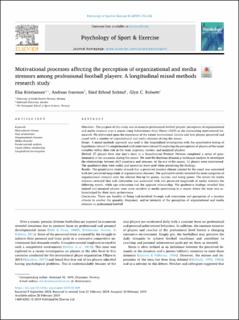| dc.contributor.author | Kristiansen, Elsa | |
| dc.contributor.author | Ivarsson, Andreas | |
| dc.contributor.author | Solstad, Bård Erlend | |
| dc.contributor.author | Roberts, Glyn | |
| dc.date.accessioned | 2020-03-20T12:41:41Z | |
| dc.date.available | 2020-03-20T12:41:41Z | |
| dc.date.created | 2019-03-11T11:30:59Z | |
| dc.date.issued | 2019 | |
| dc.identifier.citation | Psychology of Sport And Exercise. 2019, 43 172-182. | en_US |
| dc.identifier.issn | 1469-0292 | |
| dc.identifier.uri | https://hdl.handle.net/11250/2647863 | |
| dc.description.abstract | Objectives: The purpose of this study was to examine professional football players’ perceptions of organizational and media stressors over a season using Achievement Goal Theory (AGT) as the overarching motivational framework. We elaborated upon the experience of the extant motivational climate and how players perceived and coped with a number of organizational and media stressors during the season. Design: A mixed-methods approach was used in this longitudinal investigation with the quantitative testing of hypotheses (strand 1) complemented with interviews (strand II) exploring the perceptions of players of the target variables within their role in the team (captains, starters, and marginal players). Method: 27 players from one men’s team in a Scandinavian Premier Division completed a series of questionnaires at ten occasions during the season. We used the Bayesian dynamic p-technique analysis to investigate the relationships between AGT constructs and stressors. At the end of the season, 11 players were interviewed. The qualitative data were coded and narratives were used when presenting the findings. Results: The quantitative results showed that a perceived mastery climate created by the coach was associated with low perceived magnitude of organizational stressors. The qualitative results revealed the main categories of organizational stressors were the selected line-up for games, injuries, and losing games. The results for media stressors revealed that task orientation was associated with low perceived magnitude of media stressors the following month, while ego orientation had the opposite relationship. The qualitative findings revealed that injured and marginal players were more sensitive to media questioning in a season where the team was acknowledged for their team performance. Conclusions: There are benefits of being task-involved through task orientation and perception of a mastery climate to combat the quantity, frequency, and/or intensity of the perception of organizational and media stressors in professional football. | en_US |
| dc.language.iso | eng | en_US |
| dc.rights | Attribution-NonCommercial-NoDerivatives 4.0 Internasjonal | * |
| dc.rights.uri | http://creativecommons.org/licenses/by-nc-nd/4.0/deed.no | * |
| dc.title | Motivational processes affecting the perception of organizational and media stressors among professional football players: A longitudinal mixed methods research study | en_US |
| dc.type | Peer reviewed | en_US |
| dc.type | Journal article | en_US |
| dc.description.version | publishedVersion | en_US |
| dc.source.pagenumber | 172-182 | en_US |
| dc.source.volume | 43 | en_US |
| dc.source.journal | Psychology of Sport And Exercise | en_US |
| dc.identifier.doi | 10.1016/j.psychsport.2019.02.009 | |
| dc.identifier.cristin | 1683708 | |
| cristin.ispublished | true | |
| cristin.fulltext | original | |
| cristin.qualitycode | 1 | |

